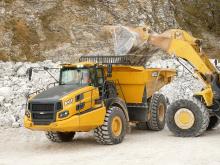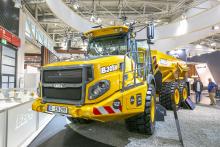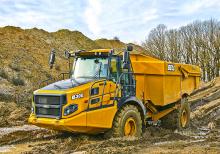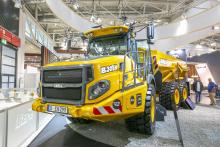
Volvo Construction Equipment (Volvo CE) has started testing the world's first fuel cell articulated hauler prototype, the Volvo HX04.
The eye-catching move follows the global off-highway machine giant's completion of a multi-stakeholder research project aimed at breaking new ground in hydrogen technology. The project's results will provide important insights into the possibilities provided by hydrogen and fuel cells as Volvo CE continues research for its future product development programmes.
Volvo CE has accelerated its work into sustainable power sources by acting on its Science Based Targets initiative (SBTi) commitment of net-zero value-chain greenhouse gas emissions by 2040 and driving industry transformation towards carbon neutrality.
Besides battery-electric solutions, where Volvo CE says it is already offering the largest range of commercial products, the company's efforts also include exploring the potential of electrification through hydrogen fuel cell technology. Now, an important milestone has been reached with the testing of a world-first, emission-free hydrogen fuel cell articulated hauler prototype, the Volvo HX04.

Carolina Diez Ferrer, head of advanced engineering programmes at Volvo CE, says: "Being inventors of the world's first articulated hauler more than 55 years ago, we are happy and proud to again drive change with this fuel cell hauler concept. While an early prototype, this innovation will give valuable insights into the opportunities of hydrogen in the energy transformation alongside battery-electric solutions. We believe that by exploring multiple technologies and working in partnership, we can create the best path forward to decarbonize the construction industry."
The Volvo HX04 is the result of a research project running between 2018 and 2022, with funding from FFI, a national collaboration between the Swedish Innovation Agency VINNOVA, Swedish Energy Agency, and Swedish Transport Administration, to support sustainable vehicle strategic research, innovation and development. Partners include Volvo CE, RISE Research Institutes of Sweden, who provided specialist competence on driveline development and safety, and PowerCell Sweden, a developer of fuel cell-based hydrogen-electric power solutions.
The development and building of the six-wheel prototype have largely been carried out at Volvo CE's facility in Braås, Sweden – the same location where Gravel Charlie, the world’s first articulated hauler, was born back in 1966, giving the Volvo HX04 the nickname Electric Charlie. Engineers at the technology centre in Eskilstuna, Sweden, have contributed with software development and knowledge gathered through its fuel cell test lab. While not commercially available, valuable insights from the concept will inevitably inform future production.
Infrastructure for hydrogen is still in development, which means refuelling the Volvo HX04 is an important aspect to solve in the project. Shell installed a state-of-the-art hydrogen refuelling station at the Volvo CE test track in Braås. Both Shell and Volvo Group are founding members of H2Accelerate, a collaboration of companies working to foster conditions for the mass market roll-out of hydrogen trucks in Europe.
The fuelling process for hydrogen vehicles is fast – the Volvo HX04 is charged with 12kg hydrogen in circa 7.5 minutes, enabling it to operate for approximately four hours. Fuel cells work by combining hydrogen with oxygen, and the resulting chemical reaction produces electricity which powers the machine. In the process, fuel cells also produce heat that can be used for the cab's heating. Fuel cells only emit one thing – water vapour.
In principle, a fuel cell works much like a battery except that it generates its own electricity from the hydrogen onboard as needed rather than being charged from an external source. Vehicles with fuel cell electric powertrains have an uptime, range, and fuelling time similar to that of combustion engine-powered vehicles.
While battery-electric vehicles and biofuels are commercially available today – as more sustainable alternatives to diesel – commercialisation of hydrogen-powered machines is expected during the second half of this decade.
International articulated dump truck (ADT) specialist Bell Equipment has been giving comprehensive details about its planned programme for the bauma 2022 quarrying, construction and mining equipment show in Munich, Germany (October 24-30).
One of the most interesting ADT innovations that Bell will be exhibiting is its autonomous vehicle operation, which the company says enables interoperability between different control systems and the trucks it produces.
An autonomous operation has three elements: machines that can be operated remotely, external sensors that become the eyes and ears of the machine, and sophisticated site control software that manages the operation based on communication with the other two elements. According to Bell Equipment ADT product marketing manager, Brad Castle: “Providing autonomous-ready machines will be a part of our core business in the future but in terms of sensing and guidance systems it makes sense to partner with market leaders and innovators, as we do with drivetrain, hydraulics and electronics technologies in our trucks.”
At the same time, Bell wants to provide a vehicle that can be fitted and controlled with a guidance system from any number of manufacturers with the easiest integration. Castle adds: “Autonomous applications are industry-specific and require surveying and guidance by an industry expert. We want our customers to be able to choose a guidance solution that they are most comfortable with and that can be fitted to all the machines in the work cycle. Keeping the guidance system independent of the OEM gives customers the flexibility to run a mixed fleet and benefit from the efficiency and productivity that it provides.”
Adding to the flexibility, Bell provides a standard cab with no extra hardware taking up space to create an environment where manual, remote or autonomous operation is interchangeable.
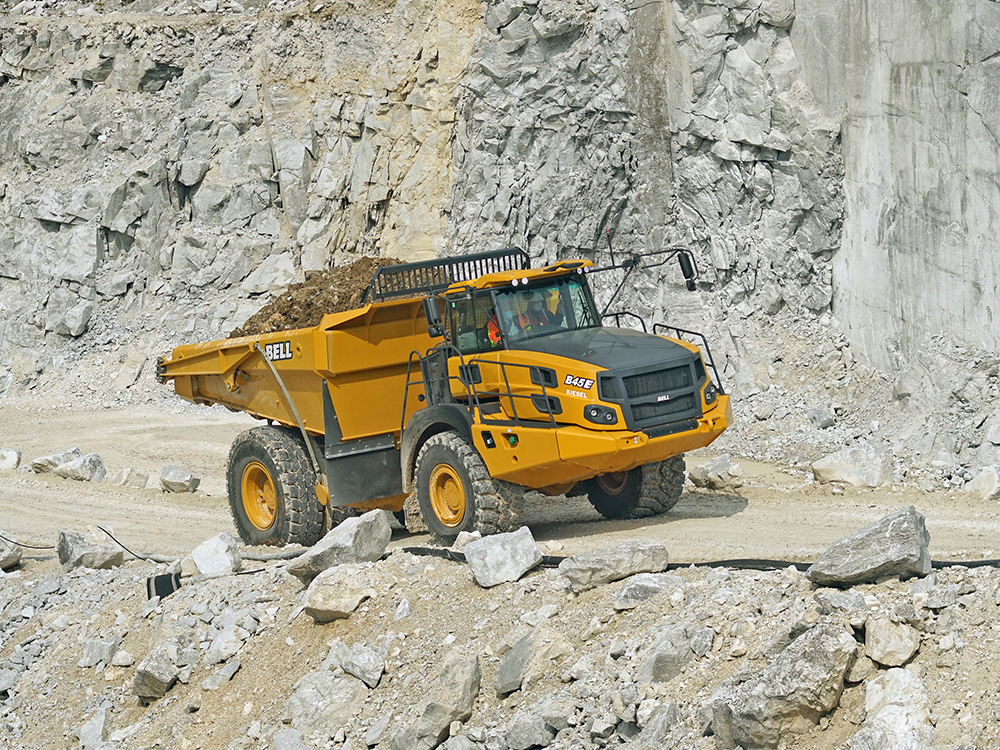
As economies of scale and technology become more affordable and reliable in the future, Bell expects to see smaller and smaller sites embracing autonomous operations.
“Support vehicles, such as service vehicles and water bowsers, may also form part of autonomous operations,” says Castle. “This would make it even more important that every machine on site, regardless of the OEM, is able to use and respond to the same software. We envisage that there could also be sites where the main earthmoving operations are fully autonomous, but support vehicles that perform a wide variety of functions are remotely operated from a central area. This would allow the site to have no people whatsoever which improves safety.”
Since early 2020, Bell has been working with tech companies indurad and voestalpine on a lime quarry site in the Alps where industrial radar specialist indurad has fitted its iTruck autonomous haulage system (AHS) on Bell B30E ADTs with what are said to be excellent results.
Also on display at bauma will be the new generation of the two-axle ADT Bell B45E 4x4 and a Bell B30E with a vehicle width of less than 3.0 metres. Bell says that both machines offer a compelling advantage to customers with specific requirements.
As a supplement to its range of seven ‘traditional’ 6x6 ADTs, with payloads from 18,000 to 45,400kg, Bell Equipment says it is the only manufacturer of articulated haulers in the world to offer a parallel range of two-axle ADTs for the past six years. All three models are aimed at different market segments. Bell adds that in the right applications they outperform conventional rigid dump trucks that need good haul roads and the three-axle ADTs designed for extreme off-road mobility.
At the upper end, the Bell B60E 4x4 – with a 55-tonne payload and 35m³ dump body capacity, is designed to be a benchmark for all-weather operations on undulating ground in opencast mines or large quarries. At the bottom of the range, the Bell B30E 4x4 (28t; 18,5m³) is a compact and highly economical solution for sand and gravel pits, material handling or underground operations.
The second-generation Bell B45E 4x4 (41t; 25m³) is aimed at small to medium-sized quarry operations. Here it competes against rigid trucks in the 45- to 55-tonne class or 6x6 ADTs with payloads of 40 tonnes or more. Compared to both types of vehicles, Bell says the 4x4 truck shows its strengths to the full in typical hard-stone quarrying on rough ground with steep climbs and tight bends.
In wet weather, conventional 4x2 rigid tippers quickly reach their limits. Bell says the all-wheel drive and oscillation joint of the B45E 4x4 always ensure high traction, and the retarder and service brakes can be applied in a very controlled manner even under full load thanks to constant ground contact by all tyres. The high power -to-weight ratio keeps cycles times low in difficult weather conditions and extends production times in exposed quarries. In addition, the Bell B45E 4x4 can be also used in overburden or new excavations.
Bell states: “While this machine does not excel in soft underfoot conditions like its 6x6 counterpart, its twin-tyred single rear axle brings substantial advantages over 6x6 ADT tandem axles on hard roads. In tight corners the tandem axle experiences significant tyre wear and wears the road down. In addition, there is greater manoeuvrability thanks to the shorter rear chassis, which, together with the rock bin typical of quarries, results in faster cycles on the quarry faces or at the primary crusher.”
At its first presentation at bauma 2019, Bell says the B45E 4x4 generated a great deal of interest, especially among Central European quarry operators as the 4x4 two-axle vehicle is well suited to their jobsites and productivity requirements. Bell Equipment's product and application specialists also recognised the potential in a segment that is characterised by a shrinking range of corresponding rigid dump truck solutions. Triggered by the company-wide transition of all Bell ADTs to EU Stage V, it was decided to revise the first generation. In addition to the Stage V improvements, a number of changes were incorporated based on user feedback from practical tests and initial customer placements.
The most significant changes relate to the rear end of the Bell B45E 4x4. The rear axle is now suspended and the bin has been heavily modified. Despite this, the frame length and wheelbase remained almost identical, making the two-axle articulated truck highly manoeuvrable (max. turning circle: 17.31m).
As with the 60-tonne Bell B60E 4x4, two oil/nitrogen hydro-pneumatic struts now take over the suspension of the rear axle from German manufacturer, Kessler. In combination with the standard adaptive "Comfort-Ride" front suspension, this provides significantly more driving comfort for a vehicle that weighs around 79 tonnes when loaded. In addition to a limited slip differential, the rear axle now also features sensor-supported automatic traction control. The new suspension geometry and kinematics have been designed to allow the 21.00 R35 twin tyres to be fitted with snow chains.
The exhaust-heated rock bin with flat bottom has been completely redesigned. For better matching with the wheeled loaders, often typical in small to medium-sized quarries, the standard bin has been lengthened and given a straight front wall. This gives a longer top edge of the body and better filling speed with wide 3.5 m³ to 6m³ rock shovels (bin height: 3,485mm).
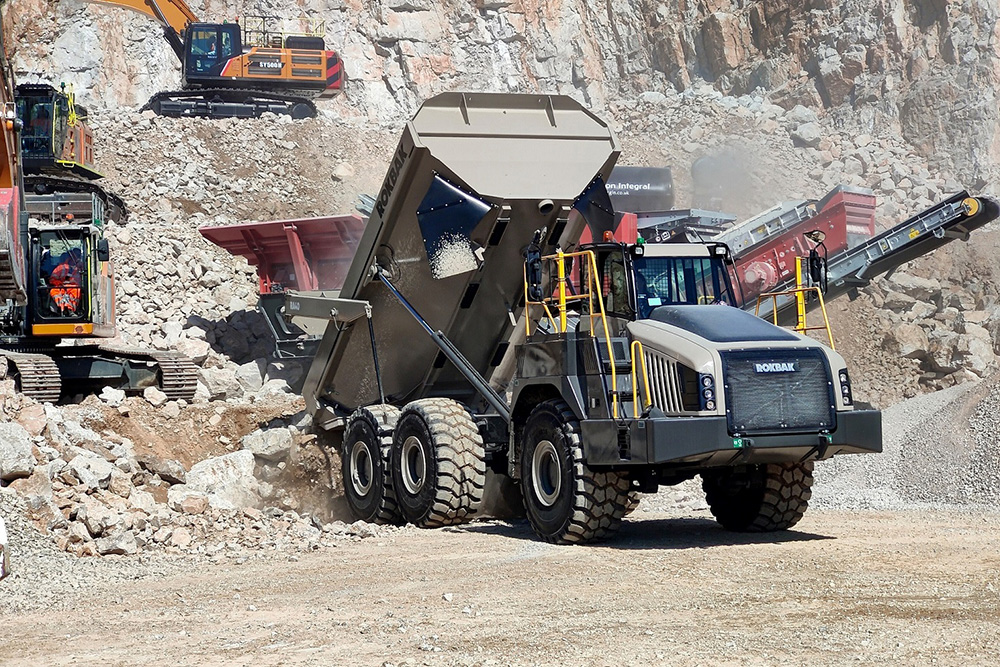
Both the maximum tipping height (6,485mm at 55°) and the large ground clearance of the chute (890mm) remain almost unchanged. This means that the articulated 41-tonne two-axle truck can be fitted into existing infrastructures (e.g., crusher enclosures) much more easily than comparable 6x6 articulated trucks with a long earthmoving body but offers advantages over conventional rigid tippers that have a low tip clearance when unloading quickly on any terrain.
The Bell B45E 4x4 has an almost identical front end to its 6x6 sister model, the B45E. Bell says this means that operators benefit from the company’s continuously developed 6x6 articulated large-series technology in terms of drive, power transmission and intelligent vehicle control. Under the bonnet is the 390kW in-line six-cylinder OM471LA from Mercedes-Benz.
ADT manufacturer Rokbak's commitment to rock-solid reliability, power and performance was in focus at June's Hillhead quarrying exhibition in Derbyshire, UK, with three of its articulated haulers on display.
The RA40 was on Rokbak's stand, and an RA30 was at the Molson Group's stand. An RA40 was working at the quarry face demonstration area, where visitors could see it doing real-world work in a live quarry environment.
"We're currently seeing huge demand for our articulated haulers, with dealers and customers excited to get hold of the new machines," said Rokbak MD Paul Douglas.
Since becoming part of the Volvo Group almost eight years ago, Rokbak has introduced multiple improvements with the aim of delivering new benchmarks in terms of hauler power, performance and total cost of ownership. For example, for the European market, the RA30 and RA40 feature the latest EU Stage V emissions-compliant engine, boasting up to a 7% improvement in fuel efficiency compared to older EU Stage IV engines.
"The machines we have on the market today are in a different league to what was on offer previously,” Douglas added. “It has been a process of continual evolution. That's why we felt it was right to recognise this evolution with a new brand name [from the previous Terex Trucks] and to launch an exciting new chapter in our history."
Rokbak has also made substantial recent investments and improvements in employees, sustainability, processes, facilities and equipment. Investments at the production site in Motherwell, Scotland, have improved safety, quality and environmental performance. These developments have also improved throughput efficiency and reduced manufacturing costs.

